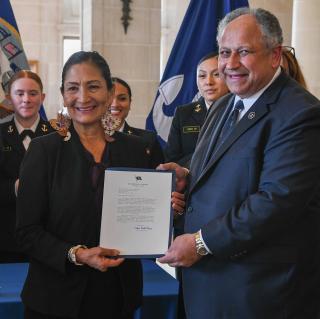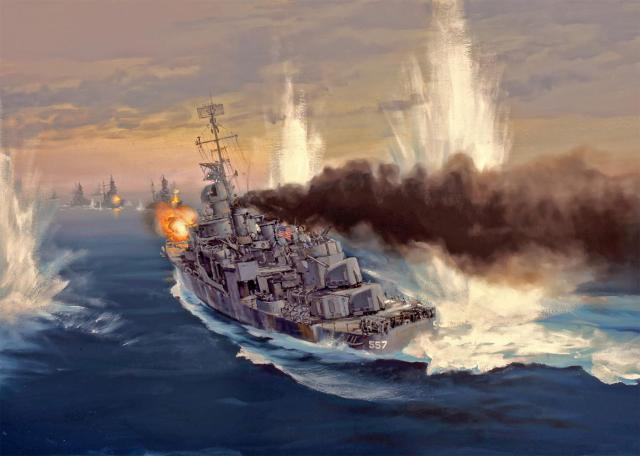Secretary of the Navy Carlos Del Toro announced in November (Native American Heritage Month) that a DDG-51 Flight III Arleigh Burke–class guided-missile destroyer will be named after World War II hero Ernest E. Evans, the first Native American in the Navy to receive the Medal of Honor and one of only two World War II destroyer captains to attain it.
Secretary Del Toro made the announcement during a ship-naming ceremony at the U.S. Naval Academy on 15 November. In addition, he announced that the ship’s sponsor will be U.S. Secretary of the Interior Deb Haaland, the first Native American to serve as a Cabinet Secretary.
“Since our nation’s founding, Native Americans, such as Ernest Evans, have volunteered to serve in our armed services,” said Secretary Del Toro. “From the Revolutionary War, the Civil War, World War I and II, to Korea, Vietnam, Desert Storm, and the conflicts in Iraq and Afghanistan, Native Americans have fought with honor and distinction to preserve our union and defend our ideals of freedom and democracy, even during periods where they were not recognized as citizens of our country.”
Secretary Haaland noted, “Today, we honor Commander Ernest Evans for his courage and ultimate sacrifice. While this nation has not always welcomed them, Native Americans have consistently and honorably served in disproportionately high rates across the armed forces to keep us safe at home and abroad. As we honor Commander Evans with this stunning vessel, we also honor the service of indigenous servicemembers nationwide, past and present. Native American history is American history, and today’s designation ensures that our story continues to be told.”
Ernest Edwin Evans was born in Pawnee, Oklahoma, on 13 August 1908. After graduating from high school, he enlisted in the U.S. Navy in 1926. After a year’s enlisted service, he was appointed to the U.S. Naval Academy, entered as a midshipman, and graduated in 1931.
In 1943, Commander Evans assumed command of the USS Johnston (DD-557), serving as her only commanding officer. During the commissioning ceremony, he told his crew and the audience assembled, “This is going to be a fighting ship. I intend to go in harm’s way, and anyone who doesn’t want to go along had better get off right now.”
On 25 October 1944, off the coast of the Philippines, Evans and the crew of the Johnston indeed found themselves in harm’s way during the culminating engagement of the Battle of Leyte Gulf—the Battle off Samar.
Evans and his fellow destroyer captains launched an offensive attack against overwhelming odds against a much larger Japanese naval force, with the Johnston in the lead. Not waiting for orders, Evans commanded the crew to begin a torpedo run, drawing fire away from carriers, directly taking hits from three powerful 14-inch guns. Despite severe damage to his ship and his own wounds from Japanese fire, Evans repeatedly put the Johnston between the enemy and more vulnerable U.S. ships, saving the lives of thousands of his fellow sailors.
Ultimately, the Johnston was lost during the battle, with Evans going down with his ship. For his leadership and selfless service in the face of a superior enemy force, he was posthumously awarded the Medal of Honor.
An earlier U.S. Navy vessel was named for Ernest Evans as well—the destroyer escort USS Evans (DE-1023), which was launched in 1955 and decommissioned in 1968.
At November’s ceremony, Secretary Del Toro remarked,“I am honored to announce that, in recognition of his heroic actions, our Navy will once again welcome a USS Ernest E. Evans into our fleet . . . as his name will adorn our future Arleigh Burke Flight III–class destroyer DDG-141.”









